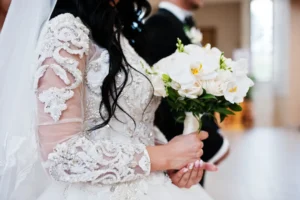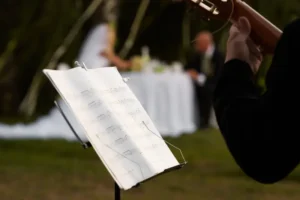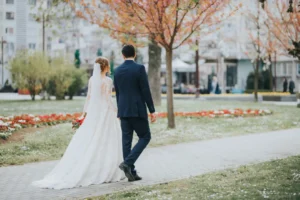Mastering Wedding Processional Order: A Step-by-Step Strategy for Your Big Day
Navigating the wedding processional order is a key element of your ceremony. Whether you’re embracing tradition or seeking a custom lineup that reflects your uniqueness, this guide clarifies who typically walks when and how to tailor the processional to your story.
Key Takeaways
- Couples can personalize the wedding processional to reflect their relationship, with flexibility in the traditional order and the choice of who escorts the bride.
- Music plays a pivotal role in setting the mood of the wedding processional and should reflect the couple’s style and story. Options range from classical to modern hits.
- Involving family and friends in the processional adds a special touch, and professional entertainment services like Kahootz can enhance the overall experience with live music and comprehensive event planning.
Understanding the Wedding Processional Order
The wedding processional refers to more than just a simple walk down the aisle. It is a choreographed dance, a procession of individuals significant to the couple, including the bridal party and the wedding party walk. This procession features:
- The wedding party
- The flower girls
- The ring bearers
- The couple and their parents
The officiant initiates the wedding processional, signaling the moment the ceremony begins.
The processional order can mirror the couple’s distinctive relationship and preferences. The bride can choose who will escort her down the aisle, bringing a personal touch to the ceremony. It’s not just about who walks down the aisle but also about the order in which they do so. Here is a suggested wedding processional order:
- Officiant
- Groom and best man
- Bridesmaids and groomsmen (in pairs)
- Maid of honor
- Flower girl and ring bearer
- Bride and her escort
A wedding planner can assist in finalizing the wedding processional order for a seamless and well-arranged ceremony.
However, it’s not always about sticking to tradition. Couples can tailor the processional order to embody their individual story. Everything from the bride’s aisle walk to the sequence of the wedding party members can be personalized to make the ceremony distinctly yours.
Traditional Wedding Processional Order
Traditional wedding processional orders can vary widely, with distinct traditions in each culture and religion present. Hindu and Jewish ceremonies, for instance, typically involve more family members than Christian or nondenominational ones.
In traditional Christian weddings, the processional begins with the bride’s mother, followed by the groom, who may enter from the side or walk down the aisle. On the other hand, Jewish wedding processionals start with the Rabbi or Cantor and typically feature the groom’s parents escorting the groom down the aisle, with grandparents also participating.
Hindu weddings are a sight to behold. The ceremony typically includes:
- The vibrant Baraat, which is the groom’s ceremonial entrance
- The bride’s family greeting the groom’s family
- Both families proceeded to the mandap
- The groom often arrives on a white horse
- Carrying the bride like a doll
All of these elements add to the grandeur of the ceremony.
Modern Wedding Processional Order
Despite the allure of traditions, contemporary couples are progressively choosing to tailor their wedding processional order to echo their distinct relationship and choices. For instance, nondenominational weddings allow for a more customized arrangement of the processional order, providing couples the flexibility to structure their ceremony differently from traditional ones.
Beyond the conventional role, alternatives exist for fathers’ aisle walks. These options offer more flexibility and personalization for the wedding ceremony. Based on the couple’s wishes, they can tailor or even exclude the choice of aisle escort. Ultimately, it’s about what resonates with you as a couple.
The bride’s entrance is another area ripe for personalization. Brides may choose whether to enter with or without an escort, and they can arrange the order of the wedding party to suit their preference. This personalized approach fosters a more significant and inclusive ceremony, genuinely mirroring the couple’s shared journey.
The Role of Music in the Wedding Processional
Let’s now delve into the role of music in the wedding processional. Music isn’t merely a backdrop; it establishes the wedding processional’s mood, profoundly shaping the event’s ambiance and leaving an indelible impression on the guests. The selection of processional music should reflect the couple’s personality, adding a personal touch and depth to the ceremony’s mood.
The couple’s music preferences are pivotal, allowing various genres and styles to be incorporated into the wedding processional to suit their unique taste. Some options for wedding processional music include:
- Classical tunes
- Modern pop hits
- Jazz standards
- Romantic ballads
- Folk songs
The music should resonate with the couple and their love story.
To make the experience even more unique, consider involving musically talented friends and family in the ceremony. This involvement personalizes the ambiance and can make the process more memorable for everyone involved.
Selecting the Perfect Songs
Choosing the ideal songs for your wedding processional goes beyond picking your cherished tunes. Factors to consider include:
- Mutual artist preferences
- A song that embodies the couple’s story
- The desired music style
- The choice between live or recorded music
These factors will help you select the perfect songs for your wedding processional.
The music for the bridal procession should maintain a relaxed tempo to match the walking pace, allowing everyone to savor the moment. It should also be easy to fade out, creating a dramatic effect for the bride’s entrance.
Don’t limit yourself to a specific genre. Explore a range of genres and consider both classic and contemporary options. This approach ensures the selected music resonates with your preferences and aligns with the wedding’s theme.
Working with Kahootz Entertainment
If you’re seeking to create the perfect musical ambiance for your wedding processional, Kahootz Entertainment is the ideal choice. They offer a range of services including:
- Live bands
- Ensembles
- DJs
- Lighting
- Décor for weddings
They are your one-stop solution for all your entertainment needs.
Kahootz Entertainment is renowned for its personalized live music services, high-quality performances, and attention to creating a unique party atmosphere. Customers have praised the company’s talent, professionalism, and ability to keep the crowd dancing.
With over two decades of experience in the entertainment industry, Kahootz Entertainment is a premier boutique entertainment company based in Boston, MA. They can significantly elevate your professional expertise, making it a wedding day highlight.
Involving Family Members and Friends in the Processional
Weddings celebrate love, not merely between the couple but also involving the dear ones who have stood by them throughout their journey. Involving family members and friends in the processional can make the ceremony even more special.
Customizing traditional roles is a great way to involve loved ones. For instance, they could carry traditional Jewish wedding canopy (chuppah) poles, officiate the Jewish wedding, or manage the wedding rings. Creating particular ceremony segments like unity candles, sand ceremonies, or tree plantings can also honor and involve loved ones, particularly in blended families.
Significant friends and family members can also be designated as ushers and greeters or given tasks such as distributing programs or confetti. Such meaningful roles can signify their importance with special attire or prominent seating.
Special Considerations for Unique Ceremony Venues
If you’re orchestrating a wedding at a distinctive ceremony venue, you should make specific considerations. You should choose the site based on its ease of access for attendees and its proximity to other attractions or accommodations.
While planning the wedding day schedule for a unique venue, you need to establish the start times of the ceremony and reception far in advance to synchronize the sequence of events and vendor coordination. Also, remember to reduce lengthy intervals between the ceremony and reception to prevent early guest arrivals from interfering with venue preparations for subsequent activities.
Your venue’s staff can be invaluable in addressing concerns and helping the wedding operations proceed smoothly. So, don’t hesitate to utilize their knowledge and assistance.
Tips for a Smooth and Memorable Wedding Processional
Planning a wedding processional might appear overwhelming, but with the right tips, it’s a walk in the park. The typical duration is three to five minutes, which is essential for planning the ceremony’s schedule. Additionally, incorporating transition times within the ceremony’s schedule can prevent rushes and accommodate unforeseen delays.
A printable wedding processional order guide can serve as a quick reference during the ceremony to ensure no one is out of place. A curated playlist for walking down the aisle can enhance the ceremony’s atmosphere and contribute to a well-structured processional.
To ensure a smooth and memorable wedding processional, consider working with professionals like Kahootz Entertainment. Their expertise in selecting engaging music can significantly elevate the experience for your guests.
Summary
Planning a wedding processional is more than deciding who walks down the aisle. It’s about creating a meaningful ceremony that reflects your unique journey as a couple, involving loved ones, and setting the tone for your special day. Whether you choose a traditional processional order or customize it to your preferences, remember to make it reflect your love story. And with the right music and a touch of creativity, your wedding processional will be a memorable highlight of your big day.
Frequently Asked Questions
What is a wedding processional?
A wedding processional is a choreographed procession marking the start of the wedding ceremony. It involves individuals significant to the couple, including the wedding party, flower girls, ring bearers, and the couple and their parents.
Can I customize my wedding processional order?
Many couples customize their wedding processional to make it more personal and reflect their unique relationship and preferences.
How important is music in the wedding processional?
Music is crucial for setting the right atmosphere during the wedding processional, influencing the overall mood, and leaving a lasting impression on the guests.
How can I involve my loved ones in the processional?
You can involve your loved ones in the processional by customizing traditional roles or creating particular ceremony segments to honor and involve them. These actions will make the event more meaningful and inclusive.
What should I consider when planning a wedding at a unique venue?
When planning a wedding at a unique venue, consider attendee access, proximity to attractions or accommodations, and event flow coordination. These elements can impact the overall experience of your special day.



